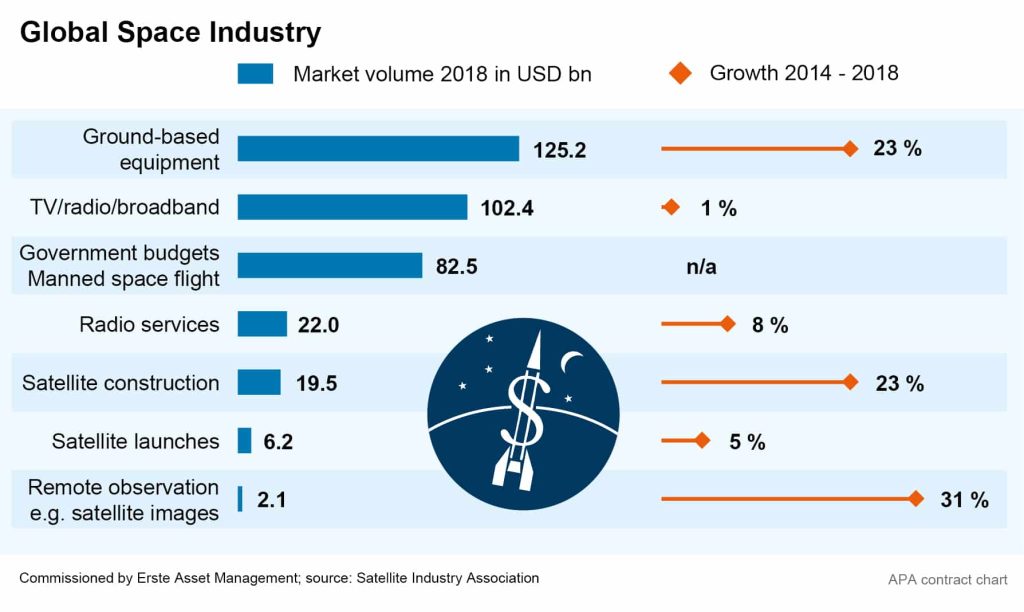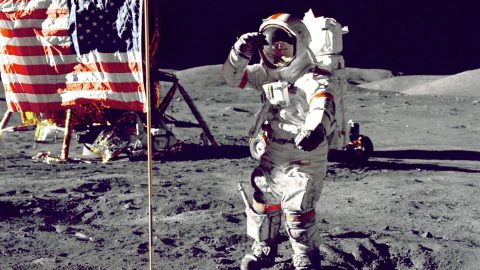
50 years ago, on 20 July 1969, Neil Armstrong and Edwin Aldrin were the first humans to set foot on the moon. The Apollo space program, launched during the Cold War, was not a commercial project, but rather politically motivated, demonstrating the USA’s determination to win the race to the moon against the Soviet Union after the defeat in the race to the Earth’s orbit. Adjusted for inflation, the “big step for mankind” cost far more than USD 100 bn by today’s standards; however, the indirect profitability for the private sector can hardly be overstated. Many of the innovations of the Lunar Landing Program found their way into the private sector and have become an indispensable part of everyday life, from microchips to wireless drills.
Since 1972, no human has been on the lunar surface, but the space industry has changed dramatically. Even in the 1960s, NASA relied on private suppliers such as Boeing, but at the time space programs were primarily run by government agencies. Today, private companies play an important role in the space business, as suppliers of space vehicles and ground equipment, as carriers of payloads into space, or as satellite operators and users.
SpaceX competes for rocket launches with NASA and ESA
Tesla CEO Elon Musk’s emerging space enterprise SpaceX provides space travel on a large-scale, focusing on mass production and recyclability in its rocket design, thereby competing with public agencies such as ESA as carriers of payloads into space. The company is now the market leader for satellite launches, continuously transporting weather or communications satellites into space and providing supply flights to the International Space Station (ISS).
Other companies are also currently attempting to enter this attractive market. In July, iSpace was the first private Chinese space company to launch a rocket into orbit. Private companies are also reaching for the stars in Europe. State-owned Swiss arms and aviation group Ruag is currently planning acquisitions worth CHF 500m to expand its space division and intends to go public in 2021 or 2022.
Space industry valued at USD 360 bn total

According to the Cologne Institute for Economic Research, the entire space industry was worth around USD 360 bn in 2018. Of this amount, 125 billion dollars were spent on ground-based equipment. At 102 billion, the transmission of TV, radio or broadband signals is the most important commercial service. Government activities and manned space flight currently amount to just under 83 billion and are thus only the third most important segment.
But this could change soon. US President Donald Trump wants US astronauts to first return to the moon in 2024, after which the next goal is Mars. Other countries, such as China or India, and even private companies, are now also targeting the moon. In early May, Amazon boss Jeff Bezos detailed his commercial ambitions regarding the Earth’s satellite: the Blue Moon landing device, which is being developed by his company Blue Origin, is to be Bezos’ contribution to the collaboration with the US space agency NASA in the new race to the moon. For the European Space Agency ESA, rocket manufacturer ArianeGroup and German company PTScientists are currently working on plans for an unmanned landing on the moon before 2025.

Legal note:
Prognoses are no reliable indicator for future performance.
Legal disclaimer
This document is an advertisement. Unless indicated otherwise, source: Erste Asset Management GmbH. The language of communication of the sales offices is German and the languages of communication of the Management Company also include English.
The prospectus for UCITS funds (including any amendments) is prepared and published in accordance with the provisions of the InvFG 2011 as amended. Information for Investors pursuant to § 21 AIFMG is prepared for the alternative investment funds (AIF) administered by Erste Asset Management GmbH pursuant to the provisions of the AIFMG in conjunction with the InvFG 2011.
The currently valid versions of the prospectus, the Information for Investors pursuant to § 21 AIFMG, and the key information document can be found on the website www.erste-am.com under “Mandatory publications” and can be obtained free of charge by interested investors at the offices of the Management Company and at the offices of the depositary bank. The exact date of the most recent publication of the prospectus, the languages in which the fund prospectus or the Information for Investors pursuant to Art 21 AIFMG and the key information document are available, and any other locations where the documents can be obtained are indicated on the website www.erste-am.com. A summary of the investor rights is available in German and English on the website www.erste-am.com/investor-rights and can also be obtained from the Management Company.
The Management Company can decide to suspend the provisions it has taken for the sale of unit certificates in other countries in accordance with the regulatory requirements.
Note: You are about to purchase a product that may be difficult to understand. We recommend that you read the indicated fund documents before making an investment decision. In addition to the locations listed above, you can obtain these documents free of charge at the offices of the referring Sparkassen bank and the offices of Erste Bank der oesterreichischen Sparkassen AG. You can also access these documents electronically at www.erste-am.com.
Our analyses and conclusions are general in nature and do not take into account the individual characteristics of our investors in terms of earnings, taxation, experience and knowledge, investment objective, financial position, capacity for loss, and risk tolerance. Past performance is not a reliable indicator of the future performance of a fund.
Please note: Investments in securities entail risks in addition to the opportunities presented here. The value of units and their earnings can rise and fall. Changes in exchange rates can also have a positive or negative effect on the value of an investment. For this reason, you may receive less than your originally invested amount when you redeem your units. Persons who are interested in purchasing units in investment funds are advised to read the current fund prospectus(es) and the Information for Investors pursuant to § 21 AIFMG, especially the risk notices they contain, before making an investment decision. If the fund currency is different than the investor’s home currency, changes in the relevant exchange rate can positively or negatively influence the value of the investment and the amount of the costs associated with the fund in the home currency.
We are not permitted to directly or indirectly offer, sell, transfer, or deliver this financial product to natural or legal persons whose place of residence or domicile is located in a country where this is legally prohibited. In this case, we may not provide any product information, either.
Please consult the corresponding information in the fund prospectus and the Information for Investors pursuant to § 21 AIFMG for restrictions on the sale of the fund to American or Russian citizens.
It is expressly noted that this communication does not provide any investment recommendations, but only expresses our current market assessment. Thus, this communication is not a substitute for investment advice.
This document does not represent a sales activity of the Management Company and therefore may not be construed as an offer for the purchase or sale of financial or investment instruments.
Erste Asset Management GmbH is affiliated with the Erste Bank and austrian Sparkassen banks.
Please also read the “Information about us and our securities services” published by your bank.

